#Benefits of Usability Testing
Explore tagged Tumblr posts
Text
How Professional Landscape Design Increases Property Value in Pune
In Pune’s competitive real estate market, every detail counts when it comes to property valuation. While interior design often takes center stage, professional landscape design is a powerful yet frequently overlooked factor that can significantly boost your property’s worth. At Floriyard, a leading provider of Landscape Development Services in Pune, we’ve seen firsthand how strategic outdoor spaces can elevate curb appeal, functionality, and market value.
Whether you're a homeowner looking to sell or a business wanting to enhance your commercial property, investing in expert landscaping delivers measurable returns. In this blog, we’ll explore: ✔ The direct correlation between landscaping and property value ✔ Key design elements that attract buyers and tenants ✔ How Floriyard’s expertise can transform your outdoor space
For businesses, we also offer Indoor and Outdoor Plant Rentals for Workspaces to create healthier, more inviting environments.
The ROI of Professional Landscaping
1. Curb Appeal = Higher First Impressions
Studies show that well-designed landscapes can increase property value by 10–20%. In Pune’s real estate market, homes with mature trees, manicured lawns, and thoughtful hardscaping sell faster and at premium prices.
2. Outdoor Living Spaces Extend Usable Square Footage
Modern buyers and commercial tenants value functional outdoor areas such as: ✔ Entertainment-ready patios (with pergolas or decking) ✔ Sustainable gardens (native plants, rainwater harvesting) ✔ Zen relaxation zones (water features, meditation corners)
These features effectively "expand" your property’s livable space without construction costs.
3. Energy Efficiency Through Smart Landscaping
Strategic tree planting and green walls can: ✔ Reduce cooling costs by up to 25% (by shading buildings) ✔ Act as windbreaks in winter ✔ Improve air quality—a selling point for health-conscious buyers
Pune-Specific Landscape Value Boosters
1. Climate-Adapted Designs
Pune’s tropical climate demands: ✔ Drought-resistant plants (like agaves and succulents) ✔ Permeable paving (to prevent monsoon waterlogging) ✔ Shade trees (e.g., Neem or Peepal) to combat summer heat
2. Low-Maintenance Luxury
Busy urban professionals prefer designs that are: ✔ Automated irrigation systems ✔ Evergreen shrubs (minimal leaf shedding) ✔ Artificial turf options (for always-green lawns)
3. Security & Privacy Enhancements
Gated communities and offices benefit from: ✔ Thorny perimeter plants (e.g., Bougainvillea) ✔ Tall bamboo screens (natural privacy walls) ✔ Lighting-integrated pathways (safety + aesthetics)
Floriyard’s Expertise: From Concept to Value Creation
Our Landscape Development Services in Pune are tailored to maximize your investment:
✔ Site Analysis – Soil testing, sun mapping, and drainage planning ✔ Custom Design – 2D/3D renderings aligned with your vision ✔ Premium Materials – Locally sourced stone, sustainable wood ✔ Smart Maintenance Plans – Seasonal care to preserve beauty
Featured Project: A Baner residence saw a 22% higher valuation after our team redesigned its backyard with a stone patio, native plant garden, and decorative lighting.
For commercial properties, pair landscaping with our Indoor and Outdoor Plant Rentals for Workspaces to impress clients and employees year-round.
Ready to Elevate Your Property’s Worth?
Invest in landscaping that pays dividends. Floriyard combines creativity, sustainability, and technical precision to deliver spaces that captivate and appreciate.
Address: Bhumkarnagar, warje, Left Bhusari Colony, Bhusari Colony, Kothrud, Pune, Maharashtra 411058 Phone: 74100 47474 Get Direction
#PuneLandscaping#PropertyValue#CurbAppeal#Floriyard#LandscapeDesign#OutdoorLiving#PuneRealEstate#SustainableGardens#CommercialLandscaping#HomeImprovement#GardenDesign#SmartLandscaping#PuneHomes#InvestInNature#LandscapeROI#UrbanGardening#PlantRentals#WorkspaceGreenery#BiophilicDesign#PuneBusiness
2 notes
·
View notes
Note
Where do I learn how to code and use linux? I want to try it but I don't know anything about coding.
I will do my best to help! The answer to that question is very long if I write it all out here, but a lot of it has been answered by other people, so I'll give you an overview and link you to some resources along the way.
The good thing is that you don't need any programming knowledge to use Linux. If you just want to try out the Linux operating system and see what it's like, I would start by downloading a program like Oracle's VirtualBox: https://www.virtualbox.org/
This will allow you to basically run a second, simulated, computer on your actual computer. From there, you can download a Linux image and install it, run it inside VirtualBox, and get familiar with the operating system. This has the additional benefit that if you do something wonky to your Linux virtual machine (VM for short) by mistake, you can just delete it and recreate it and no harm will be done to your actual computer. For a step-by-step explanation, see: https://ubuntu.com/tutorials/how-to-run-ubuntu-desktop-on-a-virtual-machine-using-virtualbox#1-overview
Short aside: Linux is not a monolithic operating system like Windows or MacOS. Linux, written by a man named Linus Torvalds, is a "kernel" made up of certain very basic computer functions, and the rest of the operating system, things like the graphical user interface (GUI, to nerds like me) doesn't come with it. To be usable by normal people, Linux has to have that functionality filled in by other programmers, which creates something called a distribution, or distro for short. Ubuntu, Debian, RedHat, Linux Mint, and OpenSUSE are all Linux distros. Different distros are designed for different purposes. Ubuntu and Mint are both pretty friendly to normal folks who want to write documents, check their email, etc. RedHat is for large companies. There's a distro called Kali that's for cybersecurity and penetration testing. Etc. etc. etc. There are tons of distros. If you don't know which one to pick, I recommend Ubuntu or Mint, as I have experience with both, and they're fairly easy to use.
From this point out, a search engine will be your best friend. There are lots of helpful tutorials online, and also answers to almost any question you can imagine. If you're unsure where to start, documentation from the website of an official Linux distribution, like Ubuntu, is usually reliable, though it can be kind of opaque if you're not used to reading tech-ese. The tutorials on Ubuntu's site, however, seem to be structured with beginners in mind, and I would run through this one to start with: https://ubuntu.com/tutorials/command-line-for-beginners#1-overview
Once you get to the point of having specific questions about how a command works or how to make the operating system do something, I would take a good look at any answers from StackOverflow, which is basically a website for computer people of all skill levels to ask each other questions ranging from the basic to the ridiculously obscure. If you're wondering it, chances are good someone on StackOverflow has asked it.
Other than that, click around your new VM, create files, find programs, etc. If you really get stuck, I'll try and help, but keep in mind I may very well be searching StackOverflow myself. XD
The other cool thing about VMs is that you can try multiple operating systems, i.e. Linux Mint (https://linuxmint-installation-guide.readthedocs.io/en/latest/) which is pretty user-friendly, as I recall.
Once you get to the point where you actually want to install Linux, you'll want to back up your computer to an external hard drive so you can restore from the backup if something goes wrong, and then follow the instructions for your chosen Linux distro. LibreOffice runs on Linux and can open most Microsoft file types, so you shouldn't need to move your files to a different type, you'll just need to copy them somewhere (like another external hard drive or a thumb drive) and then copy them back when you're done with the installation. Obligatory word of warning: installing Linux on your actual machine, as opposed to a VM, WILL OVERWRITE YOUR ENTIRE HARD DRIVE. Do this with caution. Restoring from a backup is possible, so as long as you backed everything up you will not lose any data, but it can be a pain in the neck and if you're not particularly tech-savvy, you may have to go to a computer repair store to get them to do it.
Now, as to your question about learning to code: this requires no VM and no new installation; you can start doing that today. There are almost infinite tutorials online about how to start coding. CodeCademy.com is a pretty decent one, as I recall, though it's been a long time since I used it. There's also a channel on YouTube called BroCode that puts up free 'how to get started in this programming language' tutorials, which are pretty beginner-friendly. I would recommend that you start with either Python or Java (NOT JavaScript; it's not the same thing as Java, and it's a really annoying programming language, so don't do that to yourself). Python has syntax that is more similar to English than most programming languages and it is pretty powerful, but it may confuse you when you start moving to other programming languages. Java is less immediately comprehensible but probably more representative of programming languages as a whole.
Hope this helps! Feel free to send me follow-up questions or ask for clarification if I lapsed into tech-speak and this doesn't make sense.
2 notes
·
View notes
Text
AI Agent Development: How to Create Intelligent Virtual Assistants for Business Success
In today's digital landscape, businesses are increasingly turning to AI-powered virtual assistants to streamline operations, enhance customer service, and boost productivity. AI agent development is at the forefront of this transformation, enabling companies to create intelligent, responsive, and highly efficient virtual assistants. In this blog, we will explore how to develop AI agents and leverage them for business success.

Understanding AI Agents and Virtual Assistants
AI agents, or intelligent virtual assistants, are software programs that use artificial intelligence, machine learning, and natural language processing (NLP) to interact with users, automate tasks, and make decisions. These agents can be deployed across various platforms, including websites, mobile apps, and messaging applications, to improve customer engagement and operational efficiency.
Key Features of AI Agents
Natural Language Processing (NLP): Enables the assistant to understand and process human language.
Machine Learning (ML): Allows the assistant to improve over time based on user interactions.
Conversational AI: Facilitates human-like interactions.
Task Automation: Handles repetitive tasks like answering FAQs, scheduling appointments, and processing orders.
Integration Capabilities: Connects with CRM, ERP, and other business tools for seamless operations.
Steps to Develop an AI Virtual Assistant
1. Define Business Objectives
Before developing an AI agent, it is crucial to identify the business goals it will serve. Whether it's improving customer support, automating sales inquiries, or handling HR tasks, a well-defined purpose ensures the assistant aligns with organizational needs.
2. Choose the Right AI Technologies
Selecting the right technology stack is essential for building a powerful AI agent. Key technologies include:
NLP frameworks: OpenAI's GPT, Google's Dialogflow, or Rasa.
Machine Learning Platforms: TensorFlow, PyTorch, or Scikit-learn.
Speech Recognition: Amazon Lex, IBM Watson, or Microsoft Azure Speech.
Cloud Services: AWS, Google Cloud, or Microsoft Azure.
3. Design the Conversation Flow
A well-structured conversation flow is crucial for user experience. Define intents (what the user wants) and responses to ensure the AI assistant provides accurate and helpful information. Tools like chatbot builders or decision trees help streamline this process.
4. Train the AI Model
Training an AI assistant involves feeding it with relevant datasets to improve accuracy. This may include:
Supervised Learning: Using labeled datasets for training.
Reinforcement Learning: Allowing the assistant to learn from interactions.
Continuous Learning: Updating models based on user feedback and new data.
5. Test and Optimize
Before deployment, rigorous testing is essential to refine the AI assistant's performance. Conduct:
User Testing: To evaluate usability and responsiveness.
A/B Testing: To compare different versions for effectiveness.
Performance Analysis: To measure speed, accuracy, and reliability.
6. Deploy and Monitor
Once the AI assistant is live, continuous monitoring and optimization are necessary to enhance user experience. Use analytics to track interactions, identify issues, and implement improvements over time.
Benefits of AI Virtual Assistants for Businesses
1. Enhanced Customer Service
AI-powered virtual assistants provide 24/7 support, instantly responding to customer queries and reducing response times.
2. Increased Efficiency
By automating repetitive tasks, businesses can save time and resources, allowing employees to focus on higher-value tasks.
3. Cost Savings
AI assistants reduce the need for large customer support teams, leading to significant cost reductions.
4. Scalability
Unlike human agents, AI assistants can handle multiple conversations simultaneously, making them highly scalable solutions.
5. Data-Driven Insights
AI assistants gather valuable data on customer behavior and preferences, enabling businesses to make informed decisions.
Future Trends in AI Agent Development
1. Hyper-Personalization
AI assistants will leverage deep learning to offer more personalized interactions based on user history and preferences.
2. Voice and Multimodal AI
The integration of voice recognition and visual processing will make AI assistants more interactive and intuitive.
3. Emotional AI
Advancements in AI will enable virtual assistants to detect and respond to human emotions for more empathetic interactions.
4. Autonomous AI Agents
Future AI agents will not only respond to queries but also proactively assist users by predicting their needs and taking independent actions.
Conclusion
AI agent development is transforming the way businesses interact with customers and streamline operations. By leveraging cutting-edge AI technologies, companies can create intelligent virtual assistants that enhance efficiency, reduce costs, and drive business success. As AI continues to evolve, embracing AI-powered assistants will be essential for staying competitive in the digital era.
5 notes
·
View notes
Text
Automated Testing vs. Manual Testing: Which One is Right for Your Project?
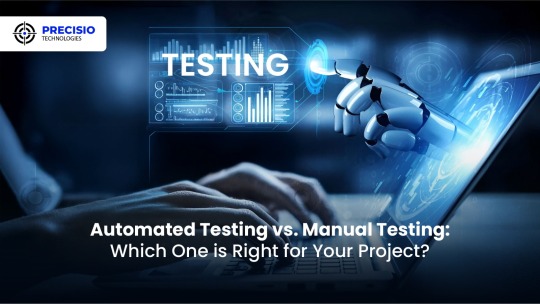
Achieving high-quality, reliable software stands as a fundamental requirement in software development. Successful testing functions as an essential tool to discover faults and build performance capabilities that create better user experience outcomes. Two main testing methods dominate the field: automated testing and manual testing. The process of quality software assurance uses different testing approaches that demonstrate their own advantages as well as weaknesses according to specific project requirements and scenarios. We will explore the specifics to determine which testing process works best for your system development efforts.
1. What Is Manual Testing?
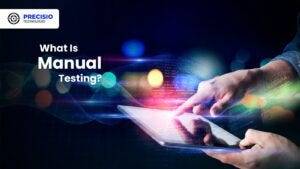
Manual testing involves a human tester manually executing test cases without using automation tools. Key Characteristics:
The methodology focuses its efforts on user interface together with usability and experience testing.
Human-centered applications where selection requires discretion include ad hoc testing and enumerative testing as well as examinations that need human evaluation.
Human performers are required during this approach; thus, it demands substantial time.
2. What Is Automated Testing?
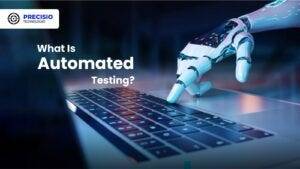
Software performing automated testing executes test cases through workflows and helpers. Key Characteristics:
Efficient for repetitive and regression testing.
Users must spend money on tools along with developing custom scripts for testing.
Reduces human error.
3. Advantages of Manual Testing

Human Intuition: Software testing professionals can detect kernels through their human cognitive ability that automated tools cannot match. The observation and evaluation of visual elements runs more efficiently through human operatives instead of advanced tools.
Flexibility: This method suits exploratory testing specifically because there are no pre-determined scripts available.
Low Initial Investment: Running this approach does not need tool purchases or applications to develop automation frameworks.
Adaptable for UI/UX Testing: Running this approach does not need tool purchases or applications to develop automation frameworks.
4. Advantages of Automated Testing
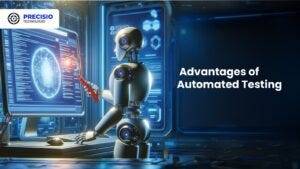
Speed: Executes repetitive tests much faster than humans.
Scalability: The system proves most effective for extensive projects that need constant system updates.
Accuracy: When performing recurring actions, automated systems minimize the chances of human mistakes.
Cost-Efficient in the Long Run: Once established and implemented, the system demands costly investments but ensures continuous development expenses decrease over time.
Better for CI/CD Pipelines: Such testing technology connects various development pipelines that support agile and DevOps methodologies.
5. Disadvantages of Manual Testing
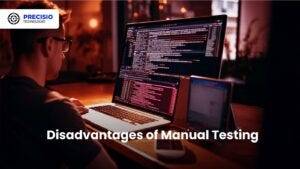
Time-Consuming: The manual performance of repeated tests leads to delayed completion of projects.
Error-Prone: Large applications contain tiny bugs that human testers commonly fail to detect.
Not Ideal for Scalability: The process of increasing manual testing needs additional testers to avoid cost escalations.
6. Disadvantages of Automated Testing

Initial Costs: Organizations must provide high financial resources to procure testing tools together with developing programming constructs.
Limited to Pre-Defined Scenarios: These testing approaches work poorly for handling exploratory or ad hoc testing.
Requires Maintenance: Test scripts need frequent updates when application changes occur.
Not Suitable for UI/UX Testing: Struggles with subjective user experience evaluations.
7. When to Use Manual Testing

Small Projects: The testing method proves beneficial at a low cost for small applications and provides quick assessments.
Exploratory Testing: Testing this approach benefits projects whose scripts have not been defined yet or need evaluation for newly added features.
Visual and Usability Testing: Performing assessments on interface components together with design features.
8. When to Use Automated Testing

Large Projects: Handles scalability for projects with frequent updates.
Regression Testing: Program testing becomes more efficient through automation since automated assessments perform multiple tests following each update process.
Performance Testing: The system performs efficient capabilities to conduct load testing and stress testing.
Continuous Development Environments: Agile progression and DevOps implementations need automation as a core requirement.
READ MORE- https://www.precisio.tech/automated-testing-vs-manual-testing-which-one-is-right-for-your-project/
2 notes
·
View notes
Text
What Are the Costs Associated with Fintech Software Development?

The fintech industry is experiencing exponential growth, driven by advancements in technology and increasing demand for innovative financial solutions. As organizations look to capitalize on this trend, understanding the costs associated with fintech software development becomes crucial. Developing robust and secure applications, especially for fintech payment solutions, requires significant investment in technology, expertise, and compliance measures. This article breaks down the key cost factors involved in fintech software development and how businesses can navigate these expenses effectively.
1. Development Team and Expertise
The development team is one of the most significant cost drivers in fintech software development. Hiring skilled professionals, such as software engineers, UI/UX designers, quality assurance specialists, and project managers, requires a substantial budget. The costs can vary depending on the team’s location, expertise, and experience level. For example:
In-house teams: Employing full-time staff provides better control but comes with recurring costs such as salaries, benefits, and training.
Outsourcing: Hiring external agencies or freelancers can reduce costs, especially if the development team is located in regions with lower labor costs.
2. Technology Stack
The choice of technology stack plays a significant role in the overall development cost. Building secure and scalable fintech payment solutions requires advanced tools, frameworks, and programming languages. Costs include:
Licenses and subscriptions: Some technologies require paid licenses or annual subscriptions.
Infrastructure: Cloud services, databases, and servers are essential for hosting and managing fintech applications.
Integration tools: APIs for payment processing, identity verification, and other functionalities often come with usage fees.
3. Security and Compliance
The fintech industry is heavily regulated, requiring adherence to strict security standards and legal compliance. Implementing these measures adds to the development cost but is essential to avoid potential fines and reputational damage. Key considerations include:
Data encryption: Robust encryption protocols like AES-256 to protect sensitive data.
Compliance certifications: Obtaining certifications such as PCI DSS, GDPR, and ISO/IEC 27001 can be costly but are mandatory for operating in many regions.
Security audits: Regular penetration testing and vulnerability assessments are necessary to ensure application security.
4. Customization and Features
The complexity of the application directly impacts the cost. Basic fintech solutions may have limited functionality, while advanced applications require more extensive development efforts. Common features that add to the cost include:
User authentication: Multi-factor authentication (MFA) and biometric verification.
Real-time processing: Handling high volumes of transactions with minimal latency.
Analytics and reporting: Providing users with detailed financial insights and dashboards.
Blockchain integration: Leveraging blockchain for enhanced security and transparency.
5. User Experience (UX) and Design
A seamless and intuitive user interface is critical for customer retention in the fintech industry. Investing in high-quality UI/UX design ensures that users can navigate the platform effortlessly. Costs in this category include:
Prototyping and wireframing.
Usability testing.
Responsive design for compatibility across devices.
6. Maintenance and Updates
Fintech applications require ongoing maintenance to remain secure and functional. Post-launch costs include:
Bug fixes and updates: Addressing issues and releasing new features.
Server costs: Maintaining and scaling infrastructure to accommodate user growth.
Monitoring tools: Real-time monitoring systems to track performance and security.
7. Marketing and Customer Acquisition
Once the fintech solution is developed, promoting it to the target audience incurs additional costs. Marketing strategies such as digital advertising, influencer partnerships, and content marketing require significant investment. Moreover, onboarding users and providing customer support also contribute to the total cost.
8. Geographic Factors
The cost of fintech software development varies significantly based on geographic factors. Development in North America and Western Europe tends to be more expensive compared to regions like Eastern Europe, South Asia, or Latin America. Businesses must weigh the trade-offs between cost savings and access to high-quality talent.
9. Partnering with Technology Providers
Collaborating with established technology providers can reduce development costs while ensuring top-notch quality. For instance, Xettle Technologies offers comprehensive fintech solutions, including secure APIs and compliance-ready tools, enabling businesses to streamline development processes and minimize risks. Partnering with such providers can save time and resources while enhancing the application's reliability.
Cost Estimates
While costs vary depending on the project's complexity, here are rough estimates:
Basic applications: $50,000 to $100,000.
Moderately complex solutions: $100,000 to $250,000.
Highly advanced platforms: $250,000 and above.
These figures include development, security measures, and initial marketing efforts but may rise with added features or broader scope.
Conclusion
Understanding the costs associated with fintech software development is vital for effective budgeting and project planning. From assembling a skilled team to ensuring compliance and security, each component contributes to the total investment. By leveraging advanced tools and partnering with experienced providers like Xettle Technologies, businesses can optimize costs while delivering high-quality fintech payment solutions. The investment, though significant, lays the foundation for long-term success in the competitive fintech industry.
2 notes
·
View notes
Text
ROPS Canopy | Best Tractor Sun Shade And Tractor Canopy

Any occupation or work area demands the assurance of comfort because extreme sunlight means non-compromising conditions. A premium ROPS canopy brings the combination of durability and shade protection, which delivers an enhanced driving experience to tractor operators. Every modern tractor requires this sturdy, installation-friendly canopy as its essential equipment.
Work Smarter with Shade That Moves With You
The weather cannot stop farming activities, while your business operation should continue without interruption. Rely on a high-quality Tractor Sun Shade to receive dependable protection from intense heat, along with eye-glare and ultraviolet rays, while maintaining complete visibility and ventilation. The daylight-shielding device stands up to wind because of its aerodynamic design while maintaining lightweight materials and all-day usability for team members.
Heavy-Duty Protection Meets Smart Design
Tough jobs need tougher gear. Climatic challenges, including dust, rain and heat, and rough terrain, cannot damage ROPS canopies in this lineup because they are made of high-impact and corrosion-resistant materials. The all-new shading solution from this canopy will keep you protected even in tasks like tilling or mowing, and hauling operations.
Style and Function in Perfect Balance
Modern agricultural tools do not require conventional, clunky equipment structures anymore. The Best Tractor Canopy available on the market combines perfectly functional design elements. This canopy incorporates smooth edges and intelligent contours while enabling users to personalise their colour choices, which delivers character and sophistication to performance. Your tractor gains distinction from others because it stands out both in agricultural fields and in all locations where it travels.
Built for the Long Haul and Hard Days
This accessory serves a bigger purpose than creating good looks. Security regulations are combined with superior strength because ROPS canopies provide essential protection when working conditions demand. The canopy framework benefits from reinforcement to handle rollovers that go beyond providing shade because it protects your equipment and user safety.
Designed for Comfort on Every Terrain
The Tractor Sun Shade follows your tractor's movement through all types of terrain, including uneven roads and open fields, without causing noise or unstable movement, or wind resistance. The precise hardware components allow for easy setup of your canopy without generating any noise during operation. Once attached, the Tractor Sun Shade functions just like your instrumental tool and serves as vital as your most essential equipment.
Shielding You from More Than the Sun
The Best Tractor Canopy possesses UV-stabilised polymers with reinforced metal brackets to maintain stability even in severe exposure conditions, while other canopy options deteriorate or degrade because of ultraviolet radiation or rust. Rain? Bring it on. Debris? Deflected. Long hours? You’re ready. Your experience of top performance becomes apparent when using this equipment.
Why Leading Farmers Choose This Equipment
When you're in the field, every second matters. This line of canopies and shades is built to deliver results that last:
Universal ROPS fits across multiple tractor brands
Lightweight construction that doesn’t affect performance
UV-resistant materials with high heat tolerance
Rust-free mounting kits with bolt-on convenience
Compatible with utility, sub-compact, and lawn tractors
Trusted across agriculture, construction, and rural sectors
Backed by product warranties and field-tested results
Designed and distributed by experts in tractor accessories
Top-Notch Protection Without the Premium Price
Your security, along with tractor protection, should lack complicated procedures and financial burdens. The canopy systems provide top-level protection together with installation convenience while offering tough durability at a reasonable price point. Your overall experience after using them will make it impossible to revert to previous methods.
It’s Time to Upgrade What’s Overhead
Your demand for shade must be realised since shade stands as an essential need. The advanced designs from Source Scan transform your tractor into a cognitive and secure machine that provides more comfort for your operations. The decision to select a proper ROPS canopy enables you to achieve better workdays both in workman operations and in recreational land management immediately.
#tractor canopy#best tractor canopy#Tractor Canopy#Tractor Accessories#Tractor Roof Canopy#Universal Tractor Canopy#Best Tractor Canopy#Rops Mounted Canopy#Rops Canopy#Tractor Sunshade#Garden Tractor Accessories#Easy-Mount Tractor Canopy#Sun Smart Tractor Accessories#Sun Smart Canopy#Fast-Install Tractor Canopy#Tractor Sun Canopy#Tractor Canopy Kit
1 note
·
View note
Text
Reliable Commercial Solar Panels by Loun Smart Technology
When it comes to energy efficiency and sustainability, businesses worldwide are turning to commercial solar panels. At Loun Smart Technology, we specialize in designing and manufacturing high-performance solar solutions tailored to meet the energy demands of various industries. As leading solar panel manufacturers, we are committed to driving innovation and delivering products that maximize energy savings while minimizing environmental impact.
Why Choose Commercial Solar Panels for Your Business?
Switching to commercial solar panels is not just a trend—it’s a smart investment. Solar energy provides clean, renewable power, significantly reducing utility costs and dependency on non-renewable resources. Businesses that adopt solar energy benefit from:
Cost Savings: Lower electricity bills by generating your own power.
Tax Incentives: Government programs often provide financial incentives for solar adoption.
Sustainability: Contribute to a greener planet by reducing your carbon footprint.
Energy Independence: Gain control over energy production and avoid price hikes in utilities.
With our advanced solar technology, Loun Smart Technology ensures every system is optimized for peak performance and longevity.
Our Expertise as Solar Panel Manufacturers
As trusted solar panel manufacturers, we prioritize quality, durability, and innovation. Here’s why Loun Smart Technology is a preferred choice:
Cutting-Edge Technology: Our solar panels incorporate the latest advancements, ensuring maximum efficiency even in low-light conditions.
Customization Options: We design systems that align with the specific needs of your business, whether you operate a small office or a large industrial facility.
Stringent Quality Control: Every product undergoes rigorous testing to meet international standards, guaranteeing reliability and safety.
Eco-Friendly Production: We adopt sustainable manufacturing practices to minimize environmental impact.
Applications of Commercial Solar Panels
Our commercial solar panels are versatile and cater to a wide range of industries, including:
Retail and Hospitality: Reduce operational costs in hotels, shopping malls, and restaurants.
Manufacturing: Power heavy machinery and streamline production processes.
Agriculture: Support irrigation systems and storage facilities with sustainable energy.
Healthcare: Ensure uninterrupted power supply in hospitals and clinics.
Education: Enable schools and universities to operate efficiently with clean energy solutions.
Each system is designed to meet the unique challenges of the industry, delivering optimal performance and savings.
The Loun Smart Technology Difference
At Loun Smart Technology, we’re more than just solar panel manufacturers; we’re partners in your journey toward energy independence. Here’s what sets us apart:
Comprehensive Support: From consultation and design to installation and maintenance, we provide end-to-end solutions.
Global Reach: Our products are trusted by businesses across the globe, reflecting our commitment to quality and customer satisfaction.
Innovative Designs: We stay ahead of industry trends to bring you the most advanced solar technology available.
Key Features of Our Commercial Solar Panels
High Efficiency: Convert sunlight into usable energy with superior efficiency rates.
Durability: Built to withstand extreme weather conditions, ensuring long-term reliability.
Scalability: Expand your solar system as your energy needs grow.
Low Maintenance: Minimal upkeep is required, making it a cost-effective energy solution.
Steps to Get Started
Adopting solar energy for your business is simple with Loun Smart Technology:
Initial Consultation: Share your energy requirements and business goals with our experts.
Custom Design: We’ll create a tailored solar solution that fits your unique needs.
Professional Installation: Our team ensures a seamless installation process for optimal performance.
Ongoing Support: Benefit from continuous monitoring and maintenance services.
Partner with Loun Smart Technology Today
Investing in commercial solar panels is an investment in your business’s future. With Loun Smart Technology, you’ll experience unmatched quality, efficiency, and support. As reliable solar panel manufacturers, we’re here to guide you through every step of the process, ensuring a seamless transition to sustainable energy.
Contact us today to learn how our commercial solar panels can transform your business operations and contribute to a cleaner, greener planet.
2 notes
·
View notes
Text
Unlock Your Dream Investment: Insider Secrets to Buying Farm Land in Chennai
Are you looking for a secure and lucrative investment in one of the most thriving cities in India? Investing in farm land in Chennai offers you more than just a property; it’s a chance to secure a promising future. Whether you're looking to develop a beautiful farmhouse, grow crops, or simply invest for future returns, purchasing farm land in Chennai can provide a range of benefits. But how do you make sure you're making the right choice? This guide will provide you with the insider secrets to buying farm land in Chennai and help you unlock the investment potential that awaits.
Why Invest in Farm Land in Chennai?
Chennai, the capital city of Tamil Nadu, has become a hotspot for real estate and agriculture-based investments. Known for its growing infrastructure, increasing demand for residential and commercial spaces, and a rich agricultural landscape, Chennai presents an excellent opportunity for investors looking to diversify their portfolios.
The city’s rapid growth is extending beyond its urban limits, making the surrounding agricultural land a prime target for investors. If you're seeking long-term returns, farm land investments in Chennai are an excellent choice due to:
Future Growth Potential: As Chennai continues to expand, areas that were once considered remote are becoming key locations for residential and commercial development. Farm land in these areas is bound to see a rise in value.
Agricultural Opportunities: If you have an interest in farming or want to start an organic farm, Chennai offers fertile lands perfect for a variety of crops. The rising demand for sustainable and organic produce adds value to agricultural investments.
Ideal for Customization: If you're interested in creating your dream farmhouse or retreat, investing in farm land gives you the freedom to design and develop your property as you see fit.
Step 1: Identify the Right Location
One of the most critical steps in buying farm land in Chennai is choosing the right location. You should focus on areas that are likely to see development in the future. Areas on the outskirts of Chennai, such as Sriperumbudur, Oragadam, and Maraimalai Nagar, are emerging as real estate hubs.
Look for land that is close to upcoming infrastructure projects like highways, transport hubs, and commercial zones. Proximity to these developments will increase the land’s value over time, making your investment more profitable.
Step 2: Research the Land’s Legal Status
Before purchasing any land, you must ensure that the title is clear and free of any legal disputes. Verify the land's ownership records with local authorities and ensure there are no encumbrances or claims from third parties. It's also important to check if the land is classified as agricultural and confirm that zoning regulations allow for the intended use.
Working with a reputable real estate agent or legal professional can help you navigate the complexities of land documents, ensuring you are protected from potential legal issues down the line.
Step 3: Evaluate the Infrastructure and Accessibility
For a farm land investment to be successful, accessibility and infrastructure are key. Assess how easy it is to reach the land and its proximity to key facilities like water sources, roads, power supply, and markets. The accessibility of your land will determine its usability, whether for farming or developing a farmhouse.
Farm land with good connectivity to main roads and transportation routes will be more valuable in the future, as it will attract potential buyers or tenants for both agricultural and residential purposes.
Step 4: Assess the Soil Quality
If your intention is to use the farm land for agricultural purposes, the quality of the soil is a critical factor to consider. Conduct soil tests to evaluate its fertility and suitability for the type of crops you intend to grow. Different regions in Chennai offer varying soil conditions, so it’s essential to understand the potential of your land before making a purchase.
Soil quality directly impacts the success of farming ventures, so make sure the land you buy can sustain your plans for cultivation.
Step 5: Understand the Investment Costs and Returns
Farm land can be an excellent long-term investment, but it's important to have a clear understanding of both the upfront costs and potential returns. The cost of land in Chennai can vary based on location, land size, and future development prospects. Calculate the total investment, including registration fees, taxes, and other associated costs, and compare it with the anticipated returns.
Keep in mind that farm land values tend to appreciate over time, especially in areas seeing growth in real estate development. When purchasing land for a future project, such as a farmhouse or commercial complex, be sure to factor in potential land value increases as part of your long-term investment strategy.
Step 6: Get Expert Guidance
Finally, it’s always a good idea to consult with real estate experts who specialize in agricultural land. A professional can help you make informed decisions, provide insights into upcoming developments, and guide you through the entire buying process.
At KG Green India Properties Pvt Ltd, we specialize in helping clients find prime farm land that meets their investment needs and future aspirations. With years of experience in the industry, we understand the nuances of the Chennai real estate market and can help you unlock the potential of your farm land investment.
Why Choose KG Green India Properties Pvt Ltd?
With a legacy of delivering quality projects since 2008, KG Green India Properties Pvt Ltd is the trusted name when it comes to investing in farm land and real estate in Chennai. We have a wide range of properties, including residential buildings, flats, bungalows, and commercial complexes, and we’re committed to ensuring that every project meets the highest standards of quality. Our expert team will guide you through every step of the process, ensuring a seamless experience from start to finish.
If you're ready to explore farm land opportunities in Chennai, reach out to us today. Let’s work together to make your dream investment a reality.
Ready to unlock your dream investment? Visit our website at KG Green India Properties Pvt Ltd to explore prime farm land opportunities and start your investment journey today!
2 notes
·
View notes
Text
Boosting Software Quality with Clarion’s Automated Software Testing Services
In the fast-paced world of technology today, maintaining the quality of software products is more important than anything else. Since software is the driving force behind most business processes, any malfunction or defect can result in serious setbacks. Therefore, automated software testing services have become a necessity for companies that want to uphold high-quality standards for their software products. Clarion, a leading software testing and quality assurance provider, offers complete QA testing solutions and software test automation solutions to assist North American and global businesses.
Why Automated Software Testing is Necessary Automated software testing has become an essential instrument for businesses aiming to streamline their software development life cycle. In contrast to manual testing, which is time-consuming and susceptible to human error, automated testing speeds up the process with greater accuracy. Automating repetitive and time-consuming tasks enables businesses to concentrate on more sophisticated and value-added areas of development. This results in quicker delivery, lower costs, and better software quality.
Clarion's automated software testing solutions offer complete end-to-end support to businesses in North America. Their team of seasoned QA engineers utilizes advanced tools and frameworks to develop tailor-made automated test scripts, so that every component of your software is thoroughly tested. From functional testing to regression testing to performance testing, Clarion's automated solutions offer a strong and scalable solution to cater to your business's specific requirements.
Benefits of Software Test Automation Services
Increased Efficiency: One of the most significant advantages of automated testing is its ability to run tests quickly and repeatedly. Automated testing can execute hundreds or even thousands of test cases in a fraction of the time it would take for a manual tester to do the same. This allows software teams to achieve faster results and move on to the next phase of development sooner.
Accuracy and Consistency: Human testers are prone to errors, especially when performing repetitive tasks. Automated tests, on the other hand, are executed with precision and consistency. The tests will always follow the same steps and provide reliable results, ensuring no detail is overlooked.
Cost-Effective: While there is an initial investment in setting up automated tests, the long-term savings are significant. Automated testing reduces the need for manual testers and minimizes the chances of bugs or issues going unnoticed. This leads to fewer defects and a lower cost of fixing those defects later in the process.
Scalability: As businesses grow, so does the complexity of their software. Automated testing can easily scale to accommodate increased demands. Clarion software test automation services is designed to grow with your business, ensuring that your testing processes remain effective, regardless of how much your software or user base expands.
Faster Time to Market: By identifying defects early and ensuring comprehensive test coverage, automated testing accelerates the software development process. This results in faster time-to-market, giving businesses in North America a competitive edge in a rapidly evolving market.
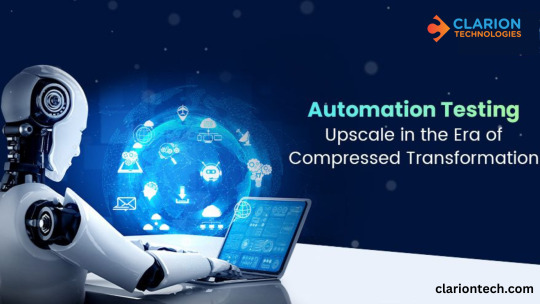
Complete QA Testing Services for North American Organizations Clarion provides a comprehensive set of QA testing services to help software products meet quality requirements. Clarion's services cover all levels of testing such as functional testing, performance testing, usability testing, and security testing. Based on Clarion's rich experience, organizations can trust their proficiency in testing every facet of their software products.
In addition, the QA testing services provided by Clarion are built to mesh well with your development process. You may be developing a mobile application, web application, or enterprise software; Clarion's QA testing team ensures that any potential problems are discovered and addressed prior to reaching the end user.
Tailored Solutions for Every Business Need Clarion realizes that each business is different, and so are its software testing needs. That's why they offer customized solutions to meet the unique needs of your business. Their staff works closely with clients to learn about the goals and challenges, so that the testing process is in line with your goals.
For companies in North America, this sort of customization and detail is key. If you're a start-up releasing your initial product or a long-time business looking to build upon existing software infrastructure, Clarion's automated software testing services and comprehensive QA solutions are what you need to help your business thrive.
Conclusion In a global landscape where the quality of software is directly reflected in a company's reputation and business success, automated testing and quality assurance are no longer discretionary measures – they are essential. Clarion QA testing services and software test automation services enable companies in North America to have absolute confidence that their software solutions comply with the most stringent quality, performance, and security standards. With emphasis on efficiency, precision, and scalability, Clarion provides a reliable solution to enable companies to remain ahead in the competitive software development environment.
#automated software testing services#qa testing services#software test automation services#software testing services#software testing services company
1 note
·
View note
Text
Why Mobile-First App Design is a Good Business Strategy (Phoenix Mobile App Design Agency)

In today's mobile-driven world, consumers rely on their smartphones for everything from communication and entertainment to shopping and banking. This shift in user behavior necessitates a mobile-first approach for businesses. Here at Net-Craft.com, a leading Phoenix mobile app design agency, we understand the power of mobile-first app design and its ability to fuel business growth.
This article explores the advantages of prioritizing mobile-first app design and how it can benefit businesses of all sizes in Phoenix and beyond.
The Rise of Mobile Users
Statistics are undeniable: mobile usage continues to soar. According to [source: Statista mobile usage statistics], over 6.6 billion people worldwide own smartphones in 2023. This translates to a massive audience readily accessible through mobile apps.
Furthermore, mobile devices are no longer just for browsing; they're primary tools for research, purchasing, and interacting with businesses. A study by [source: Business Insider mobile app usage] revealed that users spend an average of 4.2 hours daily on their smartphones, with a significant portion of that time spent on apps.
Benefits of Mobile-First App Design
By prioritizing mobile-first app design, Phoenix businesses can reap numerous benefits:
Enhanced User Experience: Mobile users expect a seamless and intuitive experience. A mobile-first approach ensures your app is optimized for smaller screens, touch interactions, and on-the-go usage, leading to higher user satisfaction and engagement.
Increased Accessibility: A mobile app makes your business accessible to users anytime, anywhere. This expands your reach and allows you to tap into a wider customer base compared to a traditional website alone.
Improved Brand Recognition: A well-designed and user-friendly mobile app strengthens your brand image and positions you as a forward-thinking, tech-savvy company.
Enhanced Customer Engagement: Mobile apps offer unique opportunities to connect with customers. Push notifications, loyalty programs, and in-app features can foster deeper engagement and build stronger customer relationships.
Data-Driven Insights: Mobile apps generate valuable user data about behavior and preferences. This data can be leveraged to personalize your marketing efforts, improve your app's functionalities, and ultimately drive business growth.
Increased Sales and Revenue: Mobile apps can streamline the purchasing process, enabling in-app purchases and convenient payment options. This can lead to increased sales and revenue for your business.
How Phoenix Mobile App Development Firms Can Help
Partnering with a Phoenix mobile app development firm like Net-Craft.com offers several advantages when implementing a mobile-first app design strategy:
Expert Design and Development: Our team of experienced mobile app designers and developers understands the nuances of mobile-first design and can create an app that is both visually appealing and functionally superior on mobile devices.
Usability Testing and Optimization: We prioritize usability testing to ensure your app is intuitive and easy to navigate on smaller screens. We iterate and optimize based on user feedback to deliver an exceptional user experience.
Cross-Platform Development: We offer cross-platform development solutions to ensure your app functions flawlessly on both iOS and Android devices, maximizing your reach and potential user base.
Mobile App Consulting in Phoenix AZ: Getting Started with Mobile-First Design
Net-Craft.com, a trusted mobile app consulting firm in Phoenix AZ, can guide you through every stage of the mobile-first app design process:
Concept Development: We work closely with you to understand your business goals and target audience. We then brainstorm app concepts and define key features that align with your mobile-first strategy.
User Interface (UI) and User Experience (UX) Design: Our design team focuses on creating an intuitive and user-friendly interface specifically optimized for mobile devices.
App Development and Testing: We leverage cutting-edge technology to develop your app and conduct rigorous testing to ensure functionality, performance, and a seamless user experience.
Deployment and Ongoing Support: We assist with app store deployment and provide ongoing support to maintain your app and address any future technical issues.
Embrace the Mobile Future with Net-Craft.com
In today's mobile-first world, a well-designed mobile app is no longer a luxury; it's a business necessity. Partnering with Net-Craft.com, a leading Phoenix mobile app design agency, can provide your business with a powerful tool to reach a wider audience, enhance customer engagement, and drive sustainable growth.
Contact us today to discuss your mobile app vision and discover how a mobile-first design approach can empower your business to thrive in the digital age.
Know more https://www.net-craft.com/blog/2024/06/28/mobile-first-app-design-phoenix/
3 notes
·
View notes
Text

Those strains of cannabis that never go out of style, Afghan Kush is one of them. It's a pure classic Indica with a rich history behind it. If you're the type of person who just likes to sit back and enjoy something, Afghan Kush is a great body-heavy strain with extremely potent effects. If you want to try it, look no further than Moonrock Online Shop.
A Little Background: Where Does Afghan Kush Come From?
Afghan Kush is a landraceg strain, meaning it's never been crossed or manipulated by growers. Its origin is the Hindu Kush mountain range, which extends across Afghanistan, Pakistan, and India, where cannabis grows wild and has done so for thousands of years.
Because it's a landrace strain, Afghan Kush is pure genetics that haven't been tampered with over time, making it extremely stable and predictable for those who like knowing exactly what they're getting in terms of effects. For cannabis lovers who appreciate strains with strong heritage, Afghan Kush is like experiencing a piece of cannabis history.
What Does Afghan Kush Feel Like?
Afghan Kush is a well-known Indica, delivering deeply relaxing effects. Many users report feeling calm, peaceful, and physically relaxed after consuming it. This makes it a popular choice for unwinding after a stressful day or helping with issues like sleeplessness.
The THC levels of Afghan Kush usually range between 16% and 20%. This can get pretty strong, though it's regularly said to be within usable levels for most people. Known to ease the suffering from stress, anxiety, or discomfort, every person does have a different experience under cannabis.
With a strong, earthy scent, somewhat spicy with a touch of pine, Afghan Kush is known for its smooth, natural taste and is well loved by many cannabis aficionados.
Reported Benefits of Afghan Kush
Though Afghan Kush is best known for its heavy sedating properties, remember that every body reacts differently to cannabis. Some reported effects of using Afghan Kush include the following:
• Pain-relieving Potential: Many people seek Indica strains, like Afghan Kush, to relieve chronic pain or muscle tension. • Reduction of Stress and Anxiety: Users report that Afghan Kush may help to relax stress or anxiety, bringing about a sense of calm. • Improvement in Sleep: If you have trouble getting to sleep or staying asleep, Afghan Kush can perhaps relax you to develop better sleep cycles.
• Increased Appetite: Some users report that Afghan Kush can increase their appetite, which may help people who have lost their appetite.
Remember, these benefits are user-reported, and the way cannabis affects one person can be quite different from another.
Where to Buy Afghan Kush Online
If you want to try Afghan Kush, you could easily order it online from the Moonrock Online Shop. They sell lab-tested, high-quality Afghan Kush to guarantee that whatever you get is pure and consistent.
Final Thoughts
Afghan Kush has become renowned as one of the classics, and for good reason. Whether you want just to chill out or de-stress, not to mention the smoothest of earthy flavors, look no further than this strain. If you haven't tried it yet, that should be added to the list for sure.
Well, for those interested, you can find Afghan Kush available at Moonrock Online Shop, where you can order directly and have a piece of cannabis history delivered right to your door for you to enjoy in the comfort of your home.
Disclosure: This post includes a link to Moonrock Online Shop, where you can purchase Afghan Kush. I am not compensated in any way for this recommendation. I just like being able to share good cannabis with the community.
1 note
·
View note
Text
What is Software Testing?

Software testing is the process of evaluating and verifying that a software product or application performs as intended. The benefits of robust testing include identifying and preventing bugs, improving performance, and ensuring the product meets user expectations and requirements.
Goals of Software Testing
The primary goals of software testing include:
Validation: Ensuring the software meets user requirements and expectations.
Verification: Confirming that the software functions correctly as per its design specifications.
Quality Assurance: Improving the reliability, performance, and security of the software.
The Evolution of Software Testing
Modern software testing emphasizes continuous testing, integrating testing processes throughout the software development lifecycle. This approach begins during the design phase, continues during development, and extends into production. Key philosophies in this domain include:
Shift-Left Testing: Incorporating testing earlier in the development process, closer to the design stage.
Shift-Right Testing: Leveraging real-world validation and feedback from end users in production environments.
To support faster delivery cycles, test automation has become essential, allowing repetitive and complex testing processes to be handled efficiently.
The Role of GenQE.ai in AI-Assisted Testing
GenQE.ai, a cutting-edge AI-powered testing tool, revolutionizes the software testing process by introducing intelligent automation and predictive insights. It enhances software quality assurance with features such as:
Automated Test Case Generation: GenQE.ai can create detailed and effective test cases based on application requirements, significantly reducing manual effort.
Predictive Defect Analysis: The AI analyzes historical and current data to predict areas with a high likelihood of defects, enabling focused testing.
Self-Adaptive Test Scripts: GenQE.ai dynamically updates test scripts to reflect changes in application design, ensuring test cases remain accurate.
Continuous Monitoring: It supports shift-left and shift-right testing by integrating seamlessly into CI/CD pipelines, offering real-time insights throughout development and production phases.
Types of Software Testing
There are various types of software testing, each serving a specific purpose:
Acceptance Testing: Verifies whether the entire system works as intended.
Code Review: Ensures adherence to coding standards and best practices.
Integration Testing: Confirms that different components or modules work together seamlessly.
Unit Testing: Validates individual software units (smallest testable components).
Functional Testing: Emulates business scenarios to test application functionalities.
Performance Testing: Evaluates software under different workloads (e.g., load testing).
Regression Testing: Ensures new features do not negatively impact existing functionality.
Security Testing: Identifies vulnerabilities and ensures system security.
Stress Testing: Determines the system's behavior under extreme conditions.
Usability Testing: Assesses how easily users can interact with the system.
Optimizing the Testing Process
A test management plan is critical to prioritizing which tests yield the most value given available time and resources. Exploratory testing complements planned tests by identifying unpredictable scenarios that may lead to errors.
How GenQE.ai Enhances Testing Efficiency
By leveraging AI to optimize test coverage and streamline processes, GenQE.ai reduces testing cycles and improves defect detection rates. It empowers teams to focus on high-priority tasks and deliver higher-quality software in less time.
Incorporating tools like GenQE.ai into your testing strategy ensures that software testing evolves alongside the complexity and speed of modern application development.
1 note
·
View note
Note
There’s a somewhat common gene mutation often seen w ADHD called MTHFR where you’re bad at breaking down B vitamins and need a special kind of more bioavailable ones so you may be B12 deficient and just not have benefitted from the b12 you took. If you’re able to, you could ask your doc to run B12, folate, vit D, and homocystine blood tests. After my malnutrition saga I had to do b12 injections and they helped a lot
This is some hella specific and usable information probably! thank u
#some shit#hope it does not offend if i dont. yknow. use it. GENUELY i think its very kind of you to share it all the same#and in that spirit. for the followers and what not
8 notes
·
View notes
Text
UI/UX Design Agency in the USA : Enhancing Digital Experiences
In today's digital age, user experience (UX) and user interface (UI) design play a critical role in the success of online businesses. As more companies realize the importance of providing intuitive and engaging digital experiences to their users, the demand for skilled UI/UX design agencies is on the rise. In the USA, particularly in California, a hub of technological innovation, UI/UX design agencies are helping businesses elevate their online presence and drive growth.
Importance of UI/UX Design for Businesses
UI/UX design is not just about making a website or app visually appealing; it's about creating an experience that delights and engages users. A well-designed user interface ensures that users can easily navigate a website or app and find the information they need. On the other hand, a good user experience design focuses on the emotional aspect of the interaction, ensuring that users have a positive impression of the brand.
What is a UI/UX Design Agency?
A UI/UX design agency is a company that specializes in creating user-friendly interfaces and experiences for websites, mobile apps, and other digital products. These agencies employ a team of designers, developers, and user experience experts who work together to create compelling digital experiences that meet the needs of both businesses and their users.
UI/UX Design Agency Services
UI/UX design agencies offer a range of services to help businesses improve their digital presence. These services may include user research, wireframing, prototyping, and usability testing. By employing a holistic approach to design, these agencies can create seamless and intuitive experiences that drive user engagement and satisfaction.
How to Choose the Right UI/UX Design Agency
Choosing the right UI/UX design agency is crucial for the success of your project. When selecting an agency, consider factors such as their portfolio, expertise, and client reviews. It's also important to ensure that the agency understands your business goals and can tailor their services to meet your specific needs.
Top UI/UX Design Agencies in the USA
The USA is home to many top-tier UI/UX design agencies that have earned a reputation for excellence in the field. Some of the leading agencies include IDEO, Frog Design, and us two. These agencies have worked with some of the biggest brands in the world and have a proven track record of delivering exceptional design solutions.
UI/UX Design Agency in California
California, with its vibrant tech scene, is a hotbed for UI/UX design agencies. Companies in California benefit from the state's innovative spirit and access to top talent. Some of the notable UI/UX design agencies in California include RNO1, Ramotion, and Clay. These agencies are known for their creative approach to design and their ability to deliver results that exceed client expectations.
Case Studies of Successful UI/UX Design Projects
To illustrate the impact of UI/UX design, we can look at some real-world examples of successful projects. For instance, Airbnb's redesign of its website and app led to a significant increase in user engagement and bookings. Similarly, the redesign of the Starbucks app resulted in a 40% increase in mobile orders. These case studies highlight the importance of investing in good design for business success.
Trends in UI/UX Design
UI/UX design is a constantly evolving field, with new trends and technologies emerging all the time. Some of the current trends in UI/UX design include dark mode, 3D elements, and micro-interactions. By staying abreast of these trends, UI/UX design agencies can create designs that feel fresh and modern.
Future of UI/UX Design
Looking ahead, the future of UI/UX design looks promising. As technology continues to advance, we can expect to see more immersive and interactive digital experiences. AI and machine learning are also likely to play a bigger role in UI/UX design, helping to personalize the user experience and streamline design processes.
Conclusion
In conclusion, UI/UX design is a critical aspect of modern business success. By investing in good design and working with a reputable UI/UX design agency, businesses can create digital experiences that delight users and drive growth. Whether you're in the USA or California, there are plenty of top-tier agencies ready to help you elevate your digital presence.
FAQs
What is the difference between UI and UX design? User interface (UI) design focuses on the visual elements of a digital product, such as layout, colors, and typography. User experience (UX) design, on the other hand, is concerned with the overall feel of the product and how users interact with it. How can UI/UX design benefit my business? UI/UX design can benefit your business by improving user satisfaction, increasing user engagement, and driving conversions. A well-designed digital product can also help enhance your brand image and credibility. How much does it cost to hire a UI/UX design agency? The cost of hiring a UI/UX design agency can vary depending on the scope of your project and the agency's expertise. It's best to get quotes from several agencies and compare their services and pricing before making a decision. What should I look for in a UI/UX design agency? When choosing a UI/UX design agency, look for a company with a strong portfolio, relevant experience, and positive client reviews. It's also important to ensure that the agency understands your business goals and can deliver results that align with your vision. How can I stay updated on the latest UI/UX design trends? To stay updated on the latest UI/UX design trends, consider following industry blogs, attending design conferences, and networking with other professionals in the field. Additionally, subscribing to design newsletters and joining online communities can help you stay informed.
3 notes
·
View notes
Text
Best Practices for Enterprise UX Design
User experience (UX) design plays a crucial role in the success of any organization, particularly in the context of large enterprises. As the digital landscape continues to evolve, creating a seamless and intuitive user interface (UI) and user experience is vital for engaging customers, increasing productivity, and driving business growth. In the realm of enterprise UX design, there are several best practices that can significantly enhance the user experience within large organizations.
Understand the User Journey: One of the fundamental principles of enterprise UX design is to thoroughly understand the user journey within the organization's digital ecosystem. This involves mapping out the various touchpoints, from initial interaction to task completion, and identifying pain points and opportunities for improvement. By gaining a deep understanding of the user journey, designers can create intuitive interfaces and experiences that align with users' needs and expectations, ultimately enhancing overall satisfaction and productivity.
Consistency Across Platforms: Large organizations often have a diverse range of digital platforms and applications. Maintaining consistency in the UI/UX design across these platforms is essential for creating a cohesive and familiar experience for users. This can be achieved through standardized design elements, such as typography, color schemes, and interaction patterns, as well as a unified design language that reflects the organization's brand identity. Consistency across platforms not only improves usability but also reinforces the organization's credibility and professionalism.
Accessibility and Inclusivity: Inclusive design is a critical aspect of enterprise UX, particularly in large organizations with diverse user bases. Designing with accessibility in mind ensures that all users, including those with disabilities, can effectively interact with digital products and services. This involves incorporating features such as screen reader compatibility, keyboard navigation, and color contrast considerations. By prioritizing accessibility, organizations can foster a more inclusive and equitable user experience for all individuals, regardless of their abilities.
User-Centric Data Security: In the context of enterprise UX design, data security and privacy are paramount considerations. Designing interfaces that prioritize user-centric data security involves implementing clear and transparent privacy settings, secure authentication processes, and proactive measures to protect sensitive information. By integrating robust security features into the UX design, organizations can instill trust and confidence in users, ultimately enhancing the overall user experience.
Iterative Testing and Feedback: Continuous testing and gathering user feedback are integral components of effective enterprise UX design. Large organizations can benefit from implementing iterative design processes that involve usability testing, user feedback sessions, and data-driven insights. By leveraging feedback from diverse user groups and stakeholders, designers can refine and optimize the UI and UX to better meet the evolving needs and preferences of the organization's user base.
Collaboration and Alignment: Effective enterprise UX design requires close collaboration and alignment across multidisciplinary teams, including designers, developers, product managers, and stakeholders. By fostering a culture of collaboration and open communication, organizations can ensure that UX design decisions are aligned with business goals, technical feasibility, and user needs. This collaborative approach facilitates the creation of cohesive and impactful user experiences that drive value for both the organization and its users.
In conclusion, enterprise UX design is a multifaceted discipline that demands a strategic and user-centric approach to creating engaging and efficient digital experiences within large organizations. By embracing best practices such as understanding the user journey, maintaining consistency across platforms, prioritizing accessibility, ensuring user-centric data security, leveraging iterative testing and feedback, and fostering collaboration and alignment, organizations can elevate their UX design efforts and deliver exceptional user experiences that drive business success. As the digital landscape continues to evolve, prioritizing enterprise UX design will be pivotal in shaping the future of user interactions within large organizations.
Experience the transformative power of exceptional UX design with Galaxy ux studio. Elevate your organization's digital presence, drive user engagement, and unlock new opportunities for growth with our expertise in Digital UI/UX design and development. Let's collaborate to create intuitive, accessible, and visually stunning user experiences that set your organization apart. Contact Galaxy UX Studio today to embark on a journey towards unparalleled UX design excellence.
5 notes
·
View notes
Text

The Ultimate Checklist For Perfect Modular Kitchen Design
Originally Posted On:- https://www.regalokitchens.com/the-ultimate-checklist-for-perfect-modular-kitchen-design.php
Careful planning, close attention to detail, and a sharp eye for both utility and aesthetics are necessary when designing the ideal modular kitchen. Whether you're renovating an existing space or starting from scratch, having a comprehensive checklist is essential to ensure every aspect of your kitchen design aligns with your needs and preferences. Additionally, using a modular layout in kitchen design can improve both aesthetics and functionality.
Regalo Kitchens is at the forefront of modular kitchen design solutions and is well-known for its creative designs and superior craftsmanship. If you're contemplating a modular kitchen for your home, here's the ultimate checklist to ensure you achieve the perfect design:
1. Assess Your Space
Before diving into any kitchen design decisions, take stock of your kitchen space. Measure the dimensions accurately, including walls, windows, doors, and any obstructions. The layout and configuration options will be influenced by your understanding of your available area.
2. Define Your Needs
Consider how you use your kitchen on a daily basis. Do you need ample storage for kitchen gadgets and appliances? Are you an avid chef who requires plenty of countertop space for prep work? Understanding your needs will shape the design and functionality of your modular kitchen.
3. Choose Your Layout Wisely
There are several layout options for modular kitchens, including L-shaped, U-shaped, galley, and island layouts. Depending on your living arrangement and available space, each plan has unique benefits. For example, a galley layout promotes productivity in small spaces, whereas an island layout encourages interaction and increased workplace.
4. Focus on Storage Solutions
One of the hallmarks of a well-designed modular kitchen design is efficient storage. Incorporate cabinets, drawers, and pull-out shelves to optimize storage space and keep your kitchen organized. Regalo Kitchens offers customizable storage solutions tailored to your specific needs.
5. Prioritize Functionality
Functionality should be at the forefront of your modular kitchen design considerations. To optimize workflow, make sure that necessary appliances—like the stove, refrigerator, and sink—form an efficient work triangle. To improve comfort and usability, include plenty of ventilation and job lighting.
6. Select Quality Materials
Invest in high-quality materials that withstand the rigors of daily use and stand the test of time. Give high priority to materials that are long-lasting and aesthetically pleasing, whether it's sturdy cabinet hardware or resilient surfaces. Regalo Kitchens provides a large selection of high-quality materials to fit your style and price range.
7. Infuse Personal Style
While functionality is paramount, don't overlook the opportunity to infuse your personal style into the design. Select hardware, paints, and finishes that go well with your overall design scheme and your sense of style. Regalo Kitchens provides adaptable modular kitchen design choices to realize your idea.
8. Embrace Innovation
Choose finishes, paints, and hardware that complement your sense of style and overall design concept. Regalo Kitchens offers flexible design options to make your vision a reality. Regalo Kitchens integrates cutting-edge technologies into its modular kitchen designs to offer unparalleled convenience.
9. Consider Sustainability
Incorporate sustainable practices and materials into your kitchen design to minimize environmental impact and promote eco-conscious living. To make your kitchen greener, choose water-saving fixtures, eco-friendly materials, and energy-efficient appliances. Regalo Kitchens is dedicated to sustainability and provides green solutions for people that care about the environment.
10. Seek Professional Guidance
Designing the perfect modular kitchen can be a daunting task, but you don't have to go it alone. Seek guidance from professional designers who specialize in modular kitchen design solutions. They can help you navigate design challenges, explore innovative options, and bring your vision to fruition. Regalo Kitchens boasts a team of experienced designers dedicated to delivering exceptional results.
Conclusion
A little bit of imagination, meticulous planning, and attention to detail go a long way toward creating the ideal modular kitchen design. By following this ultimate checklist and partnering with Regalo Kitchens, you can create a kitchen space that not only meets your practical needs but also enhances your lifestyle and reflects your unique personality. Regalo Kitchens offers the ideal modular design to let your kitchen become the focal point of your house.
Frequently Asked Questions (FAQs)
1. What are the benefits of a modular kitchen?
Modular kitchens offer numerous benefits, including efficient space utilization, customizable design options, ease of installation, and convenient maintenance. They allow homeowners to optimize storage space, incorporate modern amenities, and adapt the layout to suit their specific needs and preferences.
2. How do I determine the right layout for my modular kitchen?
The size and shape of your kitchen, your cooking style, and the amount of contact you want all play a role in selecting the ideal arrangement. Think about configurations like L-shaped, U-shaped, galley, or island, and assess how each improves efficiency and work flow in your area.
3. What materials are best suited for a modular kitchen?
The choice of materials plays a crucial role in the durability, aesthetics, and functionality of your modular kitchen design. Opt for high-quality materials such as stainless steel, granite, quartz, and laminate for countertops, cabinets, and flooring. These materials are known for their durability, resistance to moisture and heat, and ease of maintenance.
4. How can I maximize storage space in my modular kitchen?
A well-thought-out modular kitchen design must include effective storage options. To make the most of every square inch of available space, include elements like overhead storage, corner units, pull-out drawers, and tall cabinets. Consider innovative storage solutions such as carousel units, pull-out pantry shelves, and modular organizers to keep your kitchen clutter-free and organized.
5. What lighting options work best for a modular kitchen?
Proper lighting is essential for creating a functional and inviting kitchen space. Incorporate a mix of ambient, task, and accent lighting to illuminate different areas and enhance visibility. Consider options such as recessed ceiling lights, pendant lights over the island or dining area, under-cabinet lighting for task areas, and LED strips for accentuating architectural features.
#regalokitchens#modularkitchen#kitchendesign#kitchen design#modular kitchen#regalokitchen#kitchen#modular design#regalo kitchens#modular furniture
2 notes
·
View notes